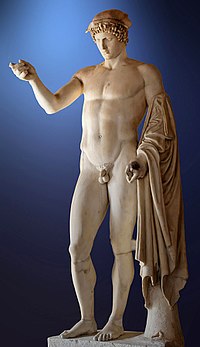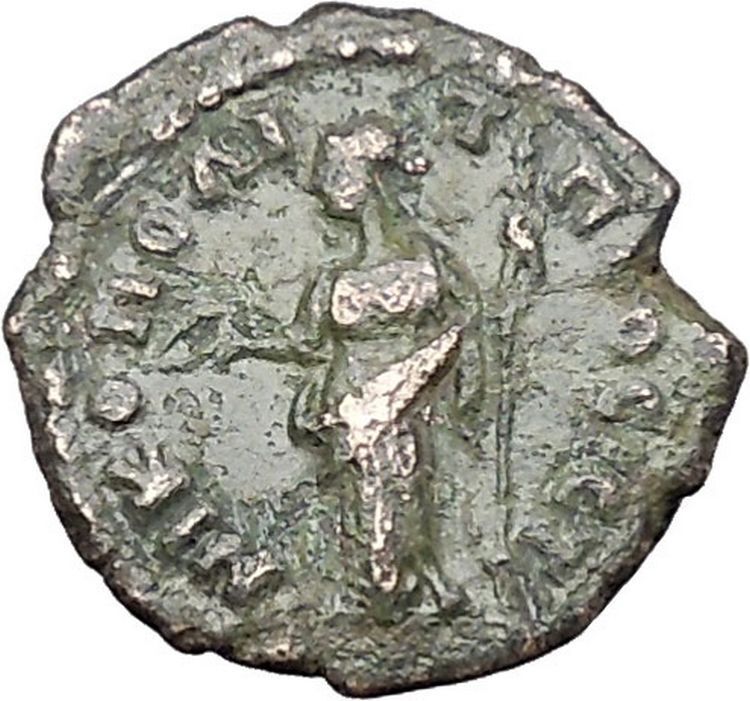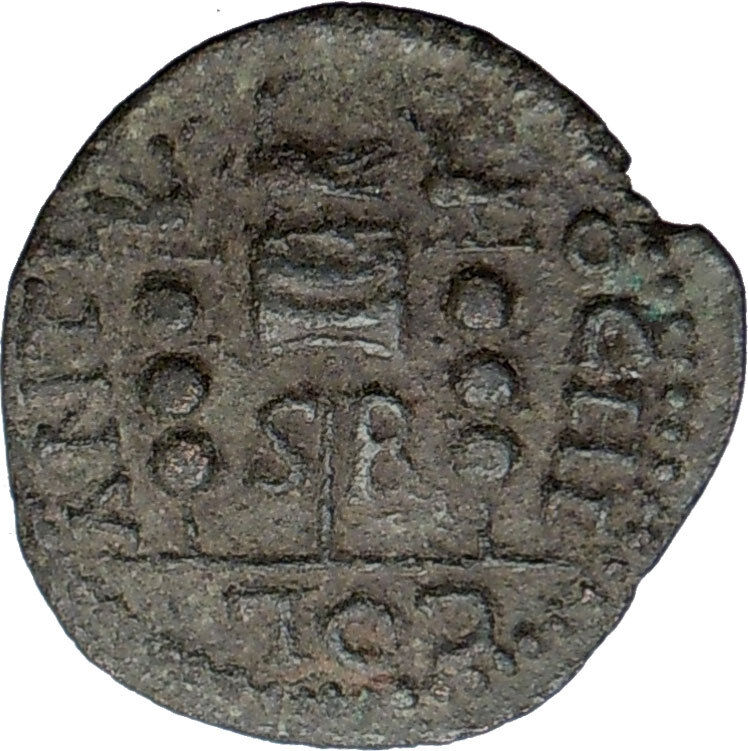|
Diadumenian
–
Roman Caesar
: 218 A.D. –
Bronze 25mm (12.85 grams) of
Nicopolis ad Istrum in Moesia Inferior
under
consular legate Statius Longinus
Bare-headed, draped and cuirassed bust right.
VΠ CTA ΛONΓINOV NIKOΠOΛITΩN ΠPOC ICTP,
Hermes
standing left, wearing petasos, with right foot set on rock, holding
winged caduceus .
You are bidding on the exact item pictured,
provided with a Certificate of Authenticity and Lifetime Guarantee of
Authenticity.
Hermes is the great messenger of the gods in
Greek mythology
and additionally as a
guide to
the Underworld
. Hermes was born on
Mount
Cyllene
in Arcadia. An
Olympian god
,
he is also the patron of boundaries and of the travelers who cross them, of
shepherds
and
cowherds
, of the
cunning
of thieves and liars, of orators and wit, of literature and poets, of athletics
and sports, of weights and measures, of invention, and of commerce in general.
His symbols include the tortoise, the rooster, the winged sandals, the winged
hat, and the caduceus
(given to him by Apollo in exchange for the lyre).
Symbols of Hermes were the palm tree, turtle, rooster, goat, the number four,
several kinds of fish, incense. Sacrifices involved honey, cakes, pigs, goats,
and lambs.
In the Roman adaptation of the Greek religion (see
interpretatio romana
), Hermes was identified with the Roman god
Mercury
, who, though inherited from the
Etruscans
, developed many similar characteristics, such as being the patron
of commerce.
The
Homeric hymn
to Hermes invokes him as the one “of many shifts (polytropos),
blandly cunning, a robber, a cattle driver, a bringer of dreams, a watcher by
night, a thief at the gates, one who was soon to show forth wonderful deeds
among the deathless gods.”
He protects and takes care of all the travelers, miscreants, harlots, old
crones
and
thieves that pray to him or cross his path. He is athletic and is always looking
out for runners, or any athletes with injuries who need his help.
Hermes is a messenger from the gods to humans, sharing this role with
Iris
.
An interpreter who bridges the boundaries with strangers is a hermeneus.
Hermes gives us our word “hermeneutics“,
the study and theory of interpretation. In Greek a lucky find was a hermaion.
Hermes delivered messages from Olympus to the mortal world. He wears shoes with
wings on them and uses them to fly freely between the mortal and immortal world.
Hermes was the second youngest of the
Olympian gods
, being born before
Dionysus
.
Hermes, as an inventor of fire, is a parallel of the
Titan
,
Prometheus
.
In addition to the lyre
,
Hermes was believed to have invented many types of racing and the sports of
wrestling and boxing, and therefore was a patron of athletes.
According to prominent
folklorist
Yeleazar
Meletinsky
, Hermes is a deified
trickster
.
Hermes also served as a
psychopomp
,
or an escort for the dead to help them find their way to the
afterlife
(the Underworld
in the Greek myths). In many Greek myths, Hermes was depicted as
the only god besides Hades
, Persephone
, Hecate
, and Thanatos
who could enter and leave the Underworld without hindrance.
Hermes often helped travelers have a safe and easy journey. Many Greeks would
sacrifice to Hermes before any trip.
In the fully-developed Olympian pantheon, Hermes was the son of
Zeus and the
Pleiade
Maia
,
a daughter of the Titan
Atlas
.
Hermes’ symbols were the
cock
and the
tortoise
,
and he can be recognized by his purse or pouch,
winged sandals
,
winged cap
, and the herald’s staff, the
kerykeion
. The night he was born he slipped away from Maia and stole his
elder brother Apollo
‘s cattle.
Nicopolis ad Istrum was a
Roman
and Early
Byzantine
town founded by Emperor
Trajan
around 101–106, at the junction of the
Iatrus (Yantra)
and the Rositsa
rivers, in memory of his victory over
the Dacians
. Its ruins are located at the village
of
Nikyup
, 20 km north of
Veliko Tarnovo
in northern
Bulgaria
. The town reached its apogee during
the reigns of Trajan,
Hadrian
, the
Antonines
and the
Severan dynasty
.

The classical town was planned according to the orthogonal system. The
network of streets, the forum surrounded by an Ionic colonnade and many
buildings, a two-nave room later turned into a basilica and other public
buildings have been uncovered. The rich architectures and sculptures show a
similarity with those of the ancient towns in Asia Minor. Nicopolis ad Istrum
had issued coins, bearing images of its own public buildings.
In
447 AD
, the town was destroyed by
Attila’s
Huns. Perhaps it was already abandoned before the early 400s. In the
6th century, it was rebuilt as a powerful fortress enclosing little more than
military buildings and churches, following a very common trend for the cities of
that century in the Danube area.The largest area of the extensive ruins (21.55
hectares) of the classical Nicopolis was not reoccupied since the fort covered
only one fourth of it (5.75 hectares), in the southeastern corner. The town
became an episcopal centre during the early Byzantine period. It was finally
destroyed by the Avar invasions at the end of the 6th century. A Bulgarian
medieval settlement arose upon its ruins later (10th-14th century).
Nicopolis ad Istrum can be said to have been the birthplace of
Germanic
literary tradition. In the 4th
century, the Gothic
bishop, missionary and translator
Ulfilas
(Wulfila) obtained permission from
Emperor
Constantius II
to immigrate with his flock of
converts to Moesia and settle near Nicopolis ad Istrum in 347-8. There, he
invented the
Gothic alphabet
and translated the
Bible
from
Greek
to
Gothic
.
Marcus Opellius Antoninus Diadumenianus or Diadumenian
(208–218) was the son of the Roman Emperor Macrinus, and served his father
briefly as Caesar (May 217–218) and as Augustus (in 218). Diadumenian was born
in 14th of September 208 a.C or according to Historia Augusta in 19th of
September 208 a.C because he shared the same birthday with the emperor Antoninus
Pius. His mother was Empress Nonia Celsa, although her existence remains
dubious, because she was only mentioned by the Historia Augusta. He was born
Marcus Opellius Diadumenianus, but his name was changed and added Antoninus to
solidify connection to the family of Marcus Aurelius as done by Caracalla.
Diadumenian had little time to enjoy his position or to learn anything from its
opportunities because the legions of Syria revolted and declared Elagabalus
ruler of the Roman Empire. When Macrinus was defeated on June 8, 218, at
Antioch, Diadumenian followed his father’s death.
|










